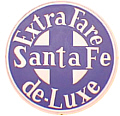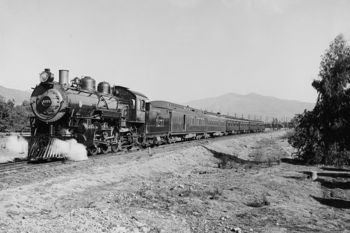Santa Fe de-Luxe: Difference between revisions
imported>Robert A. Estremo (New article generated using Special:MetadataForm) |
imported>Robert A. Estremo (article body) |
||
| Line 1: | Line 1: | ||
{{subpages}} | {{subpages}} | ||
[[Image:ATSF de-Luxe train early 1900s.jpg|thumb|right|350px|{{ATSF de-Luxe train early 1900s.jpg/credit}}<br />A Santa Fe ''de-Luxe'' train trails Baldwin 4-6-2 #1271 in 1909.]] | |||
[[Image:ATSF de-Luxe drumhead.jpg|thumb|120px|right|{{ATSF de-Luxe drumhead.jpg/credit}}<br />"[[Drumhead (sign)|Drumhead]]" logos such as this often adorned the ends of [[observation car]]s on the ''Santa Fe de Luxe''.]] | |||
The '''''de-Luxe''''' was the first extra-fare [[Named passenger trains of the Atchison, Topeka and Santa Fe Railway|named passenger trains of the Atchison, Topeka and Santa Fe Railway]] (AT&SF). The ''de-Luxe'' (meaning "...something luxurious, or elegant") was inaugurated on December 12, 1911 with a weekly schedule between [[Chicago, Illinois]], and [[Los Angeles, California]]. It was the first of Santa Fe's passenger trains to carry the slogan "Extra Fast-Extra Fine-Extra Fare" and was conceived by company president Edward Payson Ripley as the Santa Fe equivalent to the [[New York Central Railroad|New York Central's]] ''[[20th Century Limited]]'' and the [[Pennsylvania Railroad|Pennsylvania Railroad's]] ''[[Broadway Limited]]''. The complete trip between the two terminals took only 63 hours, and its 60 passengers paid a surcharge of $25 for each direction of travel. Passengers were required to board only at the terminal points, in [[Kansas City, Missouri|Kansas City]], or at the [[Williams, Arizona]] station (where those heading to the [[Grand Canyon]] disembarked and boarded a train of the [[Grand Canyon Railway]] in order to reach their destination). Upon arriving at Summit Station at the crest of the Cajon Pass, eastbound passengers were presented with orchid corsages (for the ladies) and engraved pigskin wallets (for the men). On the westbound run, ladies received a bouquet of flowers and a basket of California oranges, while the men received the customary wallet. | |||
With the outbreak of [[World War I]], the Santa Fe sought to eliminate its redundant lines. As the ''de-Luxe'' was not considered essential to the war effort, it was withdrawn from service on May 1, 1917. | |||
==Equipment== | |||
It took the [[Pullman Company]] almost a year to design and build the 12 heavyweight all-steel underframe cars that comprised the two identical consists of the ''de-Luxe'', one of these being: | |||
* [[4-6-2]] "Pacific"-type Steam Locomotive | |||
* [[Baggage car|Baggage]]-Club-[[Lounge car|Lounge]] (also included a barber shop and library) #1328 ''San Gabriel'' | |||
* [[Fred Harvey Company]] [[Dining car|Diner]] #1434 | |||
* [[Sleeping car|Sleeper]] (7 drawing rooms) ''Walpi'' | |||
* Sleeper (7 drawing rooms) ''Pima'' | |||
* Sleeper (7 compartments, 2 drawing rooms) ''Piute'' | |||
* Sleeper (7 compartments, 2 drawing rooms) ''Vaca'' | |||
* [[Observation car|Observation]]-Parlor ''El Quivira'' | |||
The cars were lavishly furnished, and were outfitted with "ice-activated" air conditioning (the first passenger train in the [[United States]] to be so equipped) and electric lighting. Drawing room passengers slept in brass beds, as opposed to the usual berths. | |||
Revision as of 14:41, 10 July 2014

"Drumhead" logos such as this often adorned the ends of observation cars on the Santa Fe de Luxe.
The de-Luxe was the first extra-fare named passenger trains of the Atchison, Topeka and Santa Fe Railway (AT&SF). The de-Luxe (meaning "...something luxurious, or elegant") was inaugurated on December 12, 1911 with a weekly schedule between Chicago, Illinois, and Los Angeles, California. It was the first of Santa Fe's passenger trains to carry the slogan "Extra Fast-Extra Fine-Extra Fare" and was conceived by company president Edward Payson Ripley as the Santa Fe equivalent to the New York Central's 20th Century Limited and the Pennsylvania Railroad's Broadway Limited. The complete trip between the two terminals took only 63 hours, and its 60 passengers paid a surcharge of $25 for each direction of travel. Passengers were required to board only at the terminal points, in Kansas City, or at the Williams, Arizona station (where those heading to the Grand Canyon disembarked and boarded a train of the Grand Canyon Railway in order to reach their destination). Upon arriving at Summit Station at the crest of the Cajon Pass, eastbound passengers were presented with orchid corsages (for the ladies) and engraved pigskin wallets (for the men). On the westbound run, ladies received a bouquet of flowers and a basket of California oranges, while the men received the customary wallet.
With the outbreak of World War I, the Santa Fe sought to eliminate its redundant lines. As the de-Luxe was not considered essential to the war effort, it was withdrawn from service on May 1, 1917.
Equipment
It took the Pullman Company almost a year to design and build the 12 heavyweight all-steel underframe cars that comprised the two identical consists of the de-Luxe, one of these being:
- 4-6-2 "Pacific"-type Steam Locomotive
- Baggage-Club-Lounge (also included a barber shop and library) #1328 San Gabriel
- Fred Harvey Company Diner #1434
- Sleeper (7 drawing rooms) Walpi
- Sleeper (7 drawing rooms) Pima
- Sleeper (7 compartments, 2 drawing rooms) Piute
- Sleeper (7 compartments, 2 drawing rooms) Vaca
- Observation-Parlor El Quivira
The cars were lavishly furnished, and were outfitted with "ice-activated" air conditioning (the first passenger train in the United States to be so equipped) and electric lighting. Drawing room passengers slept in brass beds, as opposed to the usual berths.
